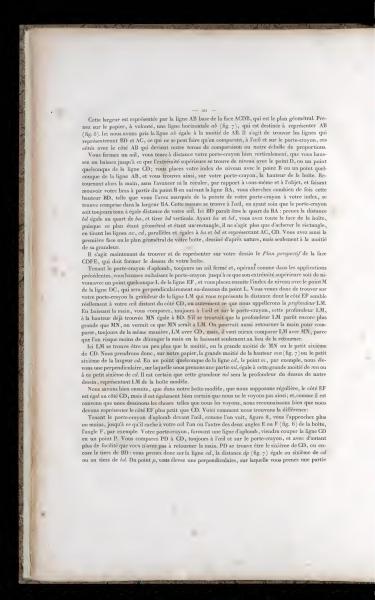The text explains a method for representing three-dimensional objects on a two-dimensional plane by using a pencil or similar tool to measure proportions visually. It guides the reader through steps to understand and replicate the dimensions of a box face using geometrical comparison techniques. The importance of comparing depths and sizes for accurate representation in perspective is emphasized.
This width is represented by the line AB at the base of the ACDB face, which is the geometrical plane. Take an arbitrary horizontal line ab (fig. 7) on your paper, intended to represent AB (fig. 6). Here we took the line ab equal to half of AB. The goal is to find the lines BD and AC, which can only be done by comparing, with your eye and using the pencil holder, these sides with side AB, which becomes our reference for comparison or our scale of proportions.
Close one eye, hold your pencil holder vertically at a distance, lowering or raising it until the top is level with point D or any other point on line CD; place your index finger at the level of point B or any point on line AB, and you will thus find, on your pencil holder, the height of the box. Then, without moving your hand forward or backward, with respect to yourself and the object, and moving your arm from point B along line BA, see how many times this height BD, as you marked from the tip of your pencil to your index, fits into the width BA.
This measurement is found visually, ensuring the pencil holder is always kept at equal distance from your eye. Here BD seems to be a quarter of BA: take the distance bd equal to a quarter of ba, and hold bd vertically. Having ba and bd, you have the entire face of the box, since this plan is geometrical and a rectangle, it's just about figuring out the rectangle by drawing the lines ac, cd, parallel and equal to ba and bd representing AC, CD. You thus have the first face of the geometrical plan of your box, drawn from nature, but only at half its real size.
Now, it's about finding and representing in your drawing the perspective plan of face CDFE, which should form the top of your box.
Hold the pencil holder upright, always with one eye closed, and following the previous steps, raise or lower the pencil holder until its top is level with any point L on line EF, and then place your index at the level of point M on line DC, which will be perpendicular below point L. You have thus found on your pencil holder the size of line LM which represents the perceived distance of side EF from side CD, or what we call the depth LM. Lowering your hand, compare, always by eye and using the pencil holder, this depth LM, to the already found MN equal to BD.
If LM appears larger than MN, one would see that LM is to LM. One could also simply turn the hand to compare, always in the same manner, LM with CD, but it's better to compare LM with MN, because there's less risk of disturbing the hand by lowering it only rather than turning it. Here, LM is a little more than half or the large half of MN or is a sixth of CD. We will then take, on our paper, the large half of height MN, and the small sixth of width cd.
At any point on line cd, point m, for example, we draw a perpendicular, on which we take a part mj, equal to this large half of mn or this small sixth of cd. It is certain that this size ml will be the depth of the top of our drawing, representing LM of the modeled box.
We also know that in our modeled box, which we assume to be regular, side EF is equal to side CD, but it is equally certain that we do not see it as such; and, as it is agreed that we draw things as we see them, we recognize that we must represent side EF smaller than CD.
Here's how we find the difference:
Holding the pencil holder upright in front of the eye, as seen in figure 8, bring it closer or farther, until it hides from your eye one of the two corners E or F (fig. 6) of the box, corner F, for example. Your pencil holder, forming a vertical line, will intersect the line CD at a point P. Compare PD to CD, always by eye and on the pencil holder, with more ease since you don't have to turn your hand. PD is found to be a sixth of CD, or alternatively a third of BD: thus, you take on line cd, the distance dp (fig. 7) equal to the sixth of cd or a third of bd.
From point p, you draw a perpendicular, on which you take a part
Translation Notes:
1. "Pencil holder" is used here as a tool for marking distances visually; it refers to using any tool like a pencil held out to measure proportions.
2. "Geometrical plan": A term used to describe a two-dimensional representation of a three-dimensional object.
